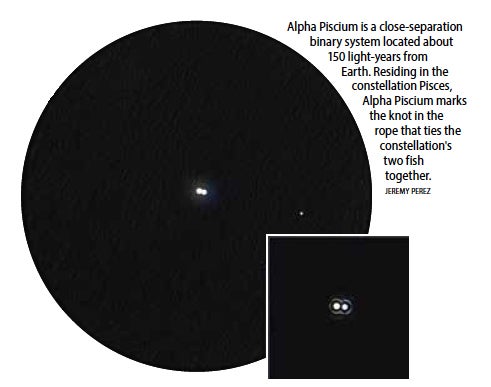A number of you were not interested in tackling an all-night event, instead requesting the Double Star Marathon list as a guide to the finest stellar pairs observable from mid-northern latitudes. A caveat: The list omits pairs not visible during Messier/Double Star Marathon time. Absent are a handful of notable doubles that inhabit parts of the constellations Pisces, Aquarius, and all of Fornax.
So without further ado, here are a half-dozen of the best “missing” doubles. Add them to the original list, and you have a pretty good sampling of the finest double stars visible from mid-northerly latitudes.
Zeta (ζ) Piscium (R.A. 1h14m, Dec. 7°35′; magnitudes: 5.2, 6.3; separation: 22.9″)
I first viewed this amply separated pair with a 3-inch f/10 reflector and magnification of 60x. In notes that accompanied a more recent observation with a 3.5-inch f/11 refractor, I wrote, “Wide pair. Primary white; companion slightly bluish.” The latter impression must have been illusory, as the secondary’s F7 spectral class would indicate a soft yellow color. What colors do you see?
This binary system has an uncertain period of more than 700 years. The pair has closed dramatically from a separation of 5.1″ at the time William Herschel discovered it in 1779, to a current separation of 1.8″. I’ve resolved this pair with a 3-inch scope at 120x, but a higher magnification is recommended for a clean split.
Omega (ω) Fornacis (R.A. 2h34m, Dec. –28°14′; magnitudes: 5.0, 7.7; separation: 1.0″)
I have a confession: While scanning the charts in Mullaney and Tirion’s Cambridge Double Star Atlas, I discovered that I’ve viewed nary a single double star in Fornax. Two are worth mentioning, and I’ll be checking them out now that Fornax is in the evening sky. The component stars of Omega Fornacis appear to be relatively fixed, having shown little change in separation since a measurement made in 1836.
Alpha (α) Fornacis (R.A. 3h12m, Dec. –28°59′; magnitudes: 4.0, 7.2; separation: 5.4″)
This is a notable binary star with a period of 269 years. When Herschel discovered them in 1835, the two were 3.0″ apart. They closed to a tight 0.9″ and then widened to their current separation of 5.4″.
Zeta (ζ) Aquarii (R.A. 22h20m, Dec. –00°01′; magnitudes: 4.3, 4.5; separation: 2.3″)
This binary has an uncertain period of around 500 to 600 years. In 1977, I split this near-twin system with a 3-inch reflector at 120x when the two were 1.8″ apart. Currently separated by 2.3″, the pair is within the grasp of a common 60mm refractor.
94 Aquarii (R.A. 23h19m, Dec. –13°28′; magnitudes: 5.3, 7.0; separation: 12.2″)
This pair, easily split at a magnification of 60x, has closed slightly since a measurement made in 1821 put it at 14.2″ apart. The primary sports a pale yellow hue, in keeping with its G5 spectral class.
By the way, I made one final tweak to the Double Star Marathon list. As mentioned here last March, I was debating whether to add Psi1 (ψ1) Piscium because it’s rather low in the west around sunset at the time of the Marathon. To address the concern, I asked for reader input. Opinions were evenly split, so I assumed the role of tiebreaker.
Although I had some difficulty locating this pair low in the still twilit western sky, it was bright enough to be easily found with a low-power sweep of the target area. Moreover, Psi1 Psc proved to be an eye-catching sight — certainly easier to spot than its nearby Messier counterpart M74. I reluctantly removed Struve 163 from the original list to make room for Psi1 Psc.
If you’d like more double star lists, try the one the Astronomical League uses for its double star certificate program. Get the list at www.astroleague.org/files/dblstar2017.pdf. Those of you with access to back issues of Deep Sky magazine also can refer to issues No. 2 through 5 (spring to winter, 1983), when I showcased the finest 25 double stars for each season.
Questions, comments, or suggestions? Email me at gchaple@hotmail.com. Next month: We celebrate the autumn version of Astronomy Day with a look at #popscope. Clear skies!











